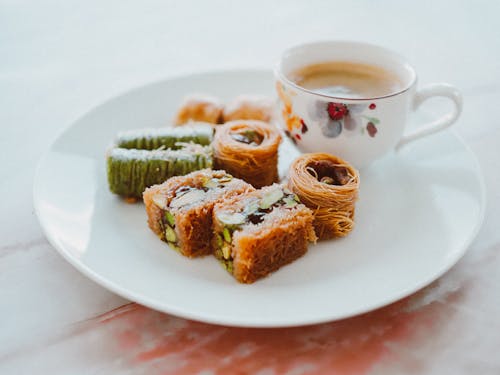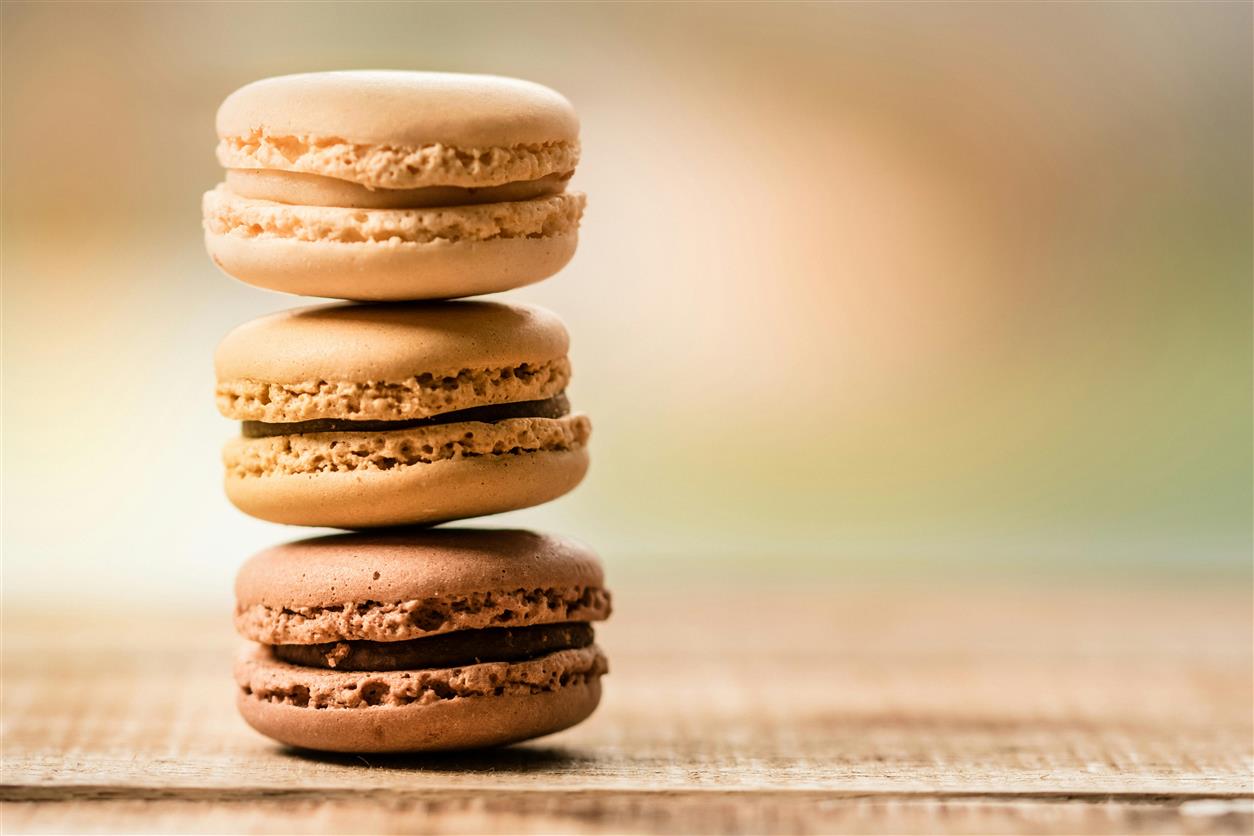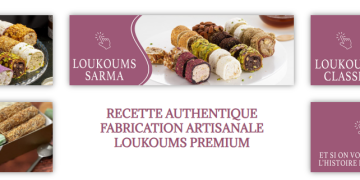
Desserts are more than just a final course in a meal; they represent the rich culinary heritage and cultural diversity of regions around the globe. Each culture has its own unique take on sweetness, from delicate pastries to rich, indulgent treats. This essay will explore an array of desserts from different cultures, highlighting their origins, ingredients, preparation methods, and the cultural significance they hold.
1. European Delights: A Tour of Classic Confections
1.1. France: Macarons and Crêpes
Macarons: These delicate, colorful confections are made from almond flour, egg whites, and sugar, and are filled with a variety of flavored creams or ganaches. Originating from Italy and popularized in France, macarons have become a symbol of French pastry perfection. The process involves whipping egg whites into stiff peaks, folding them into a mixture of almond flour and sugar, and then piping the batter onto baking sheets. The filled macarons are then aged for a day to allow the flavors to meld.
Crêpes: Thin, flat pancakes made from a batter of flour, eggs, milk, and butter, crêpes can be sweet or savory. The sweet varieties, such as crêpes Suzette, are often served with fruit preserves, chocolate, or a sprinkle of sugar. Crêpes are traditionally cooked on a large, flat griddle and folded or rolled with a variety of fillings. Their versatility and ease of preparation make them a beloved treat in France and beyond.
1.2. Italy: Tiramisu and Cannoli
Tiramisu: This no-bake dessert is made from layers of coffee-soaked ladyfingers, mascarpone cheese, eggs, and cocoa powder. Originating from the Veneto region, tiramisu is known for its creamy texture and rich coffee flavor. The name “tiramisu” means “pick me up” in Italian, referring to the energizing effects of coffee.
Cannoli: These are fried pastry shells filled with a sweet, ricotta-based filling. Cannoli originated in Sicily and are often enhanced with ingredients like chocolate chips, candied fruit, or pistachios. The crispy shell and creamy filling provide a delightful contrast in texture, making cannoli a favorite at Italian celebrations.
1.3. Spain: Churros and Flan
Churros: Fried dough pastries that are crispy on the outside and soft on the inside, churros are often coated in cinnamon sugar and served with hot chocolate for dipping. Originally from Spain, churros have spread to various countries and are enjoyed as a breakfast item or a sweet snack.
Flan: Also known as crème caramel, flan is a rich, creamy custard topped with a layer of caramel sauce. Made from eggs, milk, and sugar, flan is baked in a water bath to ensure a smooth texture. Its simplicity and elegance make it a popular choice for dessert in Spanish-speaking countries.
2. Asian Sweets: Traditional Treats and Modern Twists
2.1. Japan: Mochi and Matcha Desserts
Mochi: Made from glutinous rice that is pounded into a sticky, chewy dough, mochi is a versatile treat that can be enjoyed plain or filled with sweetened red bean paste. Traditional mochi is often eaten during Japanese New Year celebrations, but it has also been adapted into various modern desserts like mochi ice cream.
Matcha Desserts: Matcha, powdered green tea, is used in a variety of Japanese sweets. Matcha ice cream, cakes, and pastries highlight the unique, slightly bitter flavor of the tea. The bright green color and earthy taste of matcha have made it a favorite ingredient in contemporary desserts.
2.2. China: Mooncakes and Egg Tarts
Mooncakes: These are round pastries filled with sweet red bean or lotus seed paste, often enjoyed during the Mid-Autumn Festival. The traditional mooncake has a dense filling encased in a thin, tender crust and may also contain salted egg yolks. The intricate designs on the mooncakes often feature symbols of prosperity and good fortune.
Egg Tarts: With origins in both Chinese and Portuguese cuisines, egg tarts feature a flaky pastry crust filled with a smooth, custard-like egg filling. They are typically enjoyed as a dim sum item or dessert and have become popular in many countries due to their delicate flavor and texture.
2.3. India: Gulab Jamun and Jalebi
Gulab Jamun: These are deep-fried dough balls soaked in a sweet, fragrant syrup made from rose water and cardamom. Made from milk solids and flour, gulab jamun is a beloved dessert during Indian festivals and celebrations. The spongy texture and rich syrup make it a luxurious treat.
Jalebi: A popular sweet in India and neighboring countries, jalebi is made by frying a fermented batter into spirals and then soaking them in a sugar syrup. The result is a crispy, syrup-soaked treat with a vibrant orange color. Jalebi is often enjoyed warm and is a staple at festivals and weddings.
3. American Treats: From Classic Pies to Unique Innovations
3.1. United States: Apple Pie and Cheesecake
Apple Pie: Often considered the quintessential American dessert, apple pie features a flaky pastry crust filled with spiced apples. The filling is typically made with a combination of tart and sweet apples, sugar, cinnamon, and nutmeg. Apple pie is a symbol of American comfort and tradition, frequently served during holidays and family gatherings.
Cheesecake: With its creamy, rich texture, cheesecake has become a favorite dessert in the United States. The classic New York-style cheesecake is made with cream cheese, eggs, and a graham cracker crust. Variations include fruit toppings, chocolate swirls, and even savory flavors, showcasing the versatility of this dessert.
3.2. Mexico: Tres Leches Cake and Churros
Tres Leches Cake: This sponge cake is soaked in a mixture of three kinds of milk—evaporated milk, condensed milk, and heavy cream—resulting in a moist, flavorful dessert. Tres leches cake is often topped with whipped cream and fruit, making it a popular choice for celebrations in Mexico and beyond.
Churros: Similar to their Spanish counterparts, Mexican churros are enjoyed for their crisp exterior and soft interior. They are often sprinkled with cinnamon sugar and served with chocolate or caramel dipping sauces. Mexican churros are commonly enjoyed at fairs, festivals, and as street food.
4. Middle Eastern Sweets: Rich Flavors and Exotic Ingredients
4.1. Turkey: Baklava and Turkish Delight
Baklava: This rich, layered pastry is made from thin sheets of phyllo dough filled with a mixture of chopped nuts and sweetened with honey or syrup. Originating from the Ottoman Empire, baklava is known for its crispy texture and sweet, nutty flavor. It is often enjoyed with coffee or tea.
Turkish Delight (Lokum): Made from starch and sugar, Turkish Delight is a chewy, gelatinous confection often flavored with rosewater, lemon, or pomegranate and dusted with powdered sugar. Its unique texture and variety of flavors make it a beloved treat in Turkey and the surrounding regions.
4.2. Lebanon: Kanafeh and Ma’amoul
Kanafeh: This dessert features a layer of shredded phyllo dough or semolina, baked with a layer of sweet cheese or semolina pudding, and soaked in a fragrant sugar syrup. Kanafeh is known for its crispy texture and rich, sweet flavor, and is commonly enjoyed during special occasions and holidays.
Ma’amoul: These are shortbread-like cookies filled with dates, nuts, or figs. Traditionally made for religious holidays and celebrations, ma’amoul is shaped using decorative molds and often served with coffee or tea. The combination of buttery dough and sweet filling makes ma’amoul a cherished treat in Lebanon and the Middle East.

5. Conclusion
Desserts from around the world reflect the diverse cultures and culinary traditions of their regions. From the delicate macarons of France to the rich, syrup-soaked gulab jamun of India, each dessert tells a story of local ingredients, techniques, and celebrations. By exploring these sweet delicacies, we gain a deeper appreciation for the artistry and cultural significance behind each treat. Whether you are indulging in a classic American apple pie or savoring the exotic flavors of Turkish Delight, these desserts offer a delicious glimpse into the traditions and flavors that define our global culinary heritage.









